Posted by
Darrell Mordecai
Video marketing can hugely boost your ROI.
How do I know?
Ask more than 80% of marketers surveyed by Wyzowl.
- 82% of video marketers say video has helped increase the average time their consumers spend on-page
- 81% of video marketers say video has directly helped increase sales and customers
- 87% of digital video marketers say video, in general, gives them a good return on their investment
The question is…
Can you use video as an SEO strategy?
The answer is, absolutely.
In this post, I’ll show you how to make the most of search engine optimization (SEO) video marketing by getting into:
- How to do effective video keyword research
- How to rank your videos in both Google and YouTube
- SEO Video optimization best practices
In order to get started, let’s cover the big picture video SEO strategy.
Video SEO Strategy in a Nutshell – Two Options
Although there are other applications to video marketing, for this post, I’ll be focusing on video as an organic search engine marketing (SEM) strategy.
There are two completely different ways to get organic traffic to your videos. If you’re positioned correctly, you can potentially get traffic from both:
Let’s explore both…
Getting Traffic From YouTube

The first place to get online traffic is on YouTube itself. Simply speaking, YouTube is a search engine that has its own algorithms not entirely unlike Google.
This means you need to optimize your videos for the YouTube search engine. These optimizations should be built into your digital video creation process.
However, you can maximize your online traffic by also appearing on Google.
Video on the Google Search Results
The second way to get organic traffic is through the Google Search Engine Results Pages (SERPs). Google presents videos as organic results as well as in SERP features such as in video carousels.
What this means is you should try to find keywords that are both searched on YouTube and have videos on the Google search results.
To do that you’ll need to have a research process.
I’ll be showing you how you can do this using some online research tools most of which are free.
I’ll also show you how you can scale this process up using the Rank Ranger rank tracking software. If you don’t have access to Rank Ranger, you can still do most of this research, but Rank Ranger will streamline the process.
Let’s jump in…
YouTube SEO
Since the first place to get online traffic is on the YouTube search engine, to get started you must:
- Find YouTube keywords that have search volume
- Find video topics that aren’t too competitive
- Figure out how to rank those videos
YouTube Keyword Research
As you know, keyword research is at the heart of any good SEO strategy and I’ll start by introducing a few free options that will help you get the job done. I’ll show you a great tool later.
1. Google Keyword Research Search Volumes (Surprise! Surprise!)
Now, I do understand that YouTube and Google are different search engines and the keyword search volumes are obviously different. But, seeing a significant search volume for a search term on Google informs you that there is an audience that wants to understand the topic.
For instance, if you look up the term ‘how to optimize my google my business’ you’ll see it gets 390 searches per month. This means that there is an audience of people who want to know how to do this.
However, when learning new skills, some people prefer written material and others prefer video content. In other words, I’m suggesting that the search intent should be the same on YouTube as on Google (although search volumes will differ.)
The Google search volume is an indicator that there is also likely to be search volume on YouTube.
I’m not suggesting you should only look at Google search volumes. Instead, you should qualify the results by looking at YouTube Autosuggest. To do that, simply type your term into the YouTube search bar.
2. Qualify Search Volumes With YouTube Autosuggest
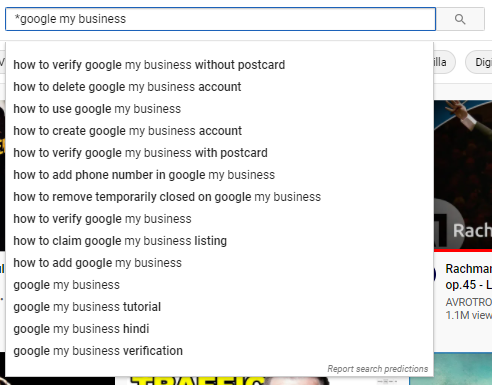
YouTube Autosuggest showing trending search terms for the term ‘google my business’
Granted, this process will not show you specific search volumes, but you can see if there are common or trending searches. I think YouTube Autosuggest is useful because I assume YouTube Autosuggest works in a similar way to Google’s Autosuggest.
Google explains how they create these suggestions:
‘We look at the real searches that happen on Google and show common and trending ones relevant to the characters that are entered and also related to your location and previous searches.’
This means if Google’s Autosuggest uses common and trending searches, it’s a fair assumption that YouTube works the same way.
3. Use Google Trends Data
Another free way to qualify if a video keyword has search volume is by looking at Google Trends. It’s important to note that Google Trends will not show you search volumes, but it will show you the overall popularity of a search term. What’s great about it is you can set it to show keyword trends for YouTube.
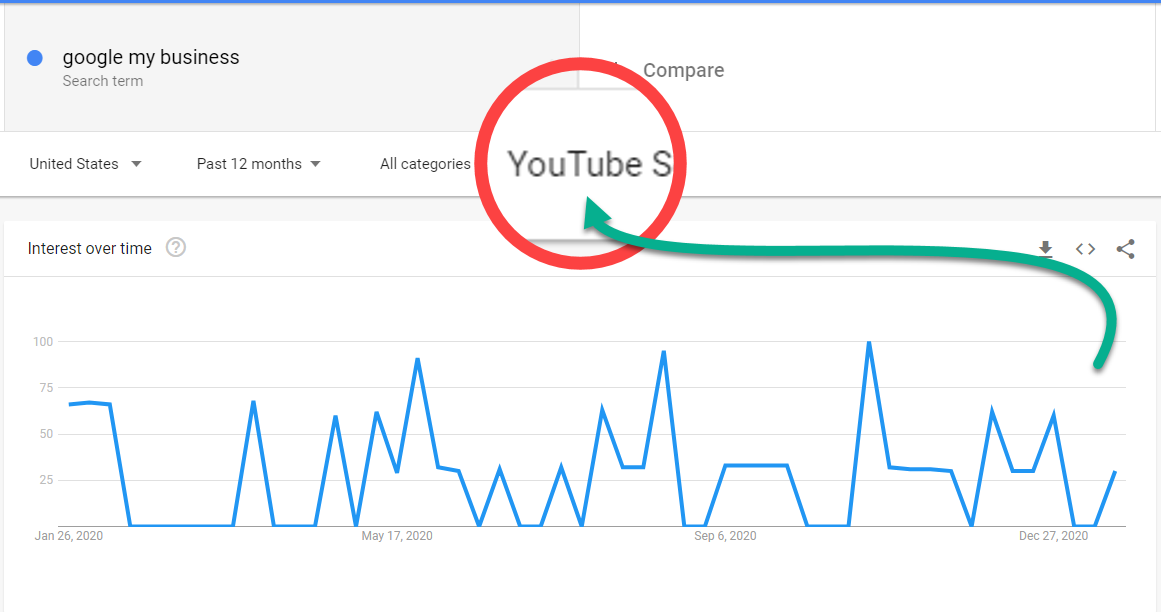
Google Trends showing trending searches in YouTube for the term ‘google my business’
4. Complete your video SEO strategy with SimilarWeb’s Marketing Trends Tool
There is also a tool on the market that will provide you with deeper insights.
SimilarWeb’s Marketing Trends keyword research tool for Youtube comes in handy when doing video SEO.
I’ll show you a couple of features I find helpful.
If you have an account you can find it here: SimilarWeb-PRO > Acquisitions Channels > SEO > Keyword Generator
And make sure to select the Youtube search engine:
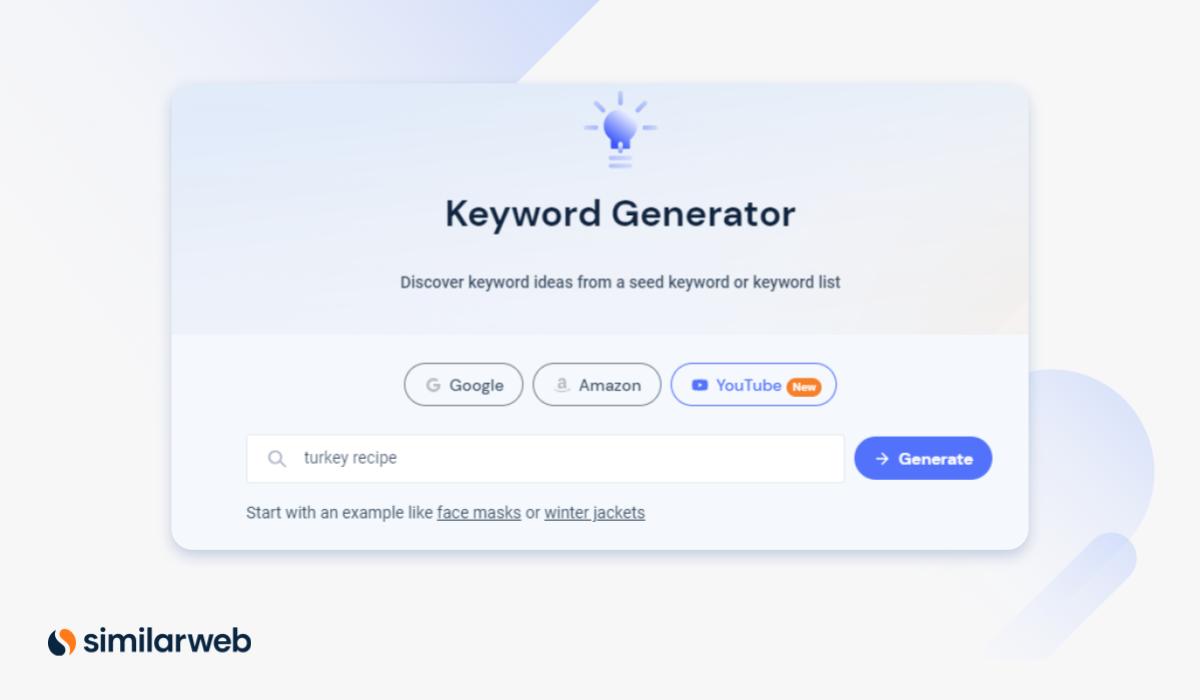
Once you’ve searched for a keyword, check out the volume trends to understand the traffic potential.
Volume Trends
For instance…
Looking at the trends for “turkey recipe”, there is a clear spike in the searches for cooking a whole turkey for Thanksgiving. This is not a surprise in any way and on average this happens once per year per household.
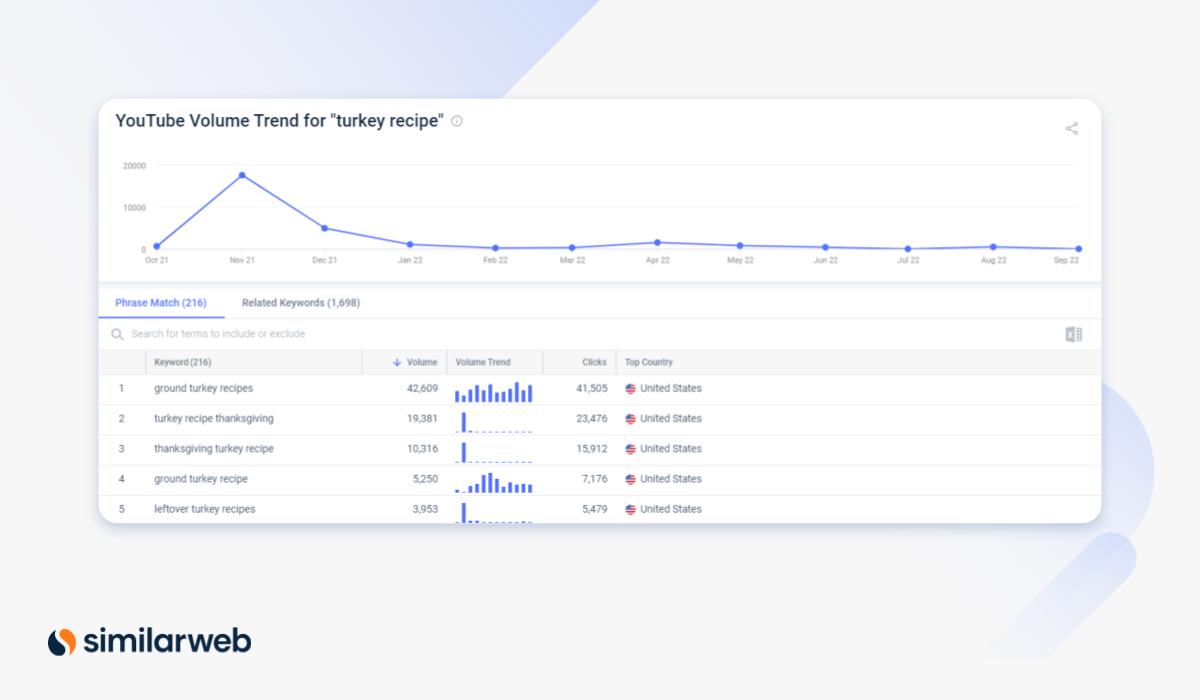
What is worth noting is that there are more than twice as many searches for ground turkey recipes all year round.
If you are putting a recipe collection together, selling turkey meat, or if this relates to your line of business in any way, it could definitely be worth investing some time in new and creative ways of cooking ground turkey and mixing it up a bit according to the season and present it to your buyer to maximize their purchase experience while, more importantly, increasing your own sales.
By the way, if you are struggling to find sub-topics to broaden your content while building authority, make sure to check out Related Keywords where you can find some very interesting suggestions to dive deeper into, especially on evergreen content.
Related Keywords
For example, if I search the query “growing orchids” and when I switch over to Related Keywords, I see some relevant topics it could be worthwhile producing new content on that someone searching for the keyword “growing orchids” is likely to also be interested in:
- transplant orchids to larger pot
- how can i keep my orchid from dying
- orchid reblooming
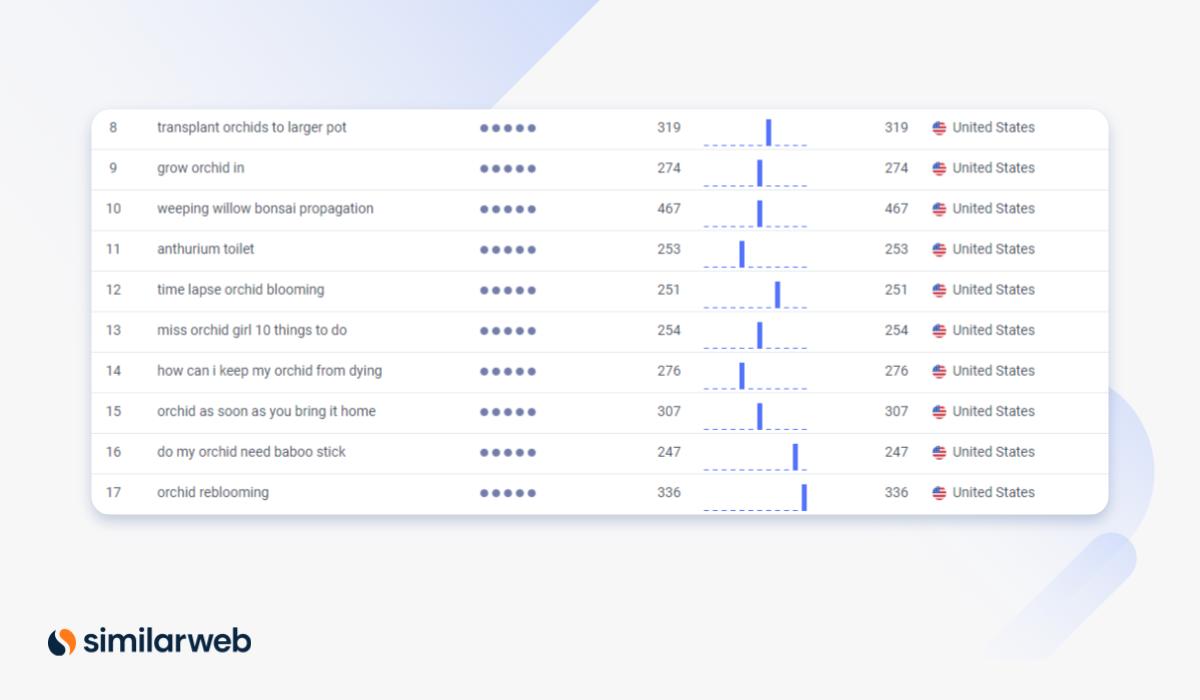
Once you’ve found a keyword topic to create a video around, use your rank tracking tool that tracks YouTube search results. For this example, I’ll be using the Rank Ranger Rank Tracker Dashboard.
The point of this section is to show you a number of metrics that will help you increase your effectiveness with clear data.
Rank Tracker Dashboard
Use the Rank Tracker dashboard to see how your videos are ranking on YouTube. The dashboard will show you at a glance how your rankings are changing over time. Therefore, when you make changes to your video, you can track how those changes affected your rankings.
In order for the dashboard to work for you, first set up a YouTube tracking campaign. You’ll also need to track your target keywords. If you want the benefit of our other tools, you should track the keywords for at least 30 days.
![]()
For this example, I’ll be looking at the keyword ‘polestar 2 vs tesla model 3’.
Once you’ve been tracking your target keyword for 30 days, get insights into how to rank at the top of YouTube by clicking the arrow icon. This will show you a visibility graph, which is useful if you already have videos that are currently ranking.
If you’ve not yet created your video and you’re looking for insights into how to rank your video or if you are looking for insights to increase your rankings, click the SEO Monitor button above the visibility graph.
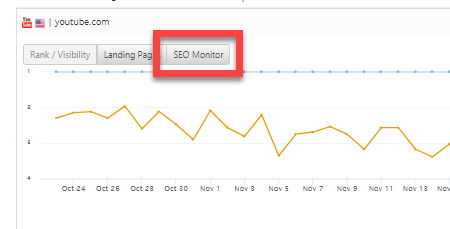
This will take you to the SEO Monitor.
SEO Monitor
Once you’ve found a topic you want to rank, use the SEO Monitor to understand:
- How competitive that topic really is
- Which videos are favored by YouTube
To do that, you can use the SEO Monitor to track the stability of the first 20 video spots on YouTube.
For instance, if we look at the keyword ‘polestar 2 vs tesla model 3’ in the SEO Monitor, we see relative chaos.

In the screenshot above, you can see a graph showing the top 20 rankings over the last 30 days.
What stands out in this screenshot is, that the top four rankings are stable. Below that, there are wild rank fluctuations on a daily basis. This means two things:
- Since the search engine is volatile below position four, YouTube is not ‘happy’ with those videos. This means those spots are relatively less competitive than the top four spots.
- If you want to improve your rankings, study the top four more stable videos and create something even better.
This means the best strategy here is to create a video that’s designed to be one of those stable rankings. In order to do that, you should create a video that is better and more thorough than the top four stable videos.
At this stage you should have a video topic that:
- Gets a decent amount of search volume
- Is not too competitive
Now, before actually creating your video, you should first find opportunities to rank your videos on Google…
Rank your videos on the Google Search Results
As I mentioned above, YouTube traffic isn’t the only way to get traffic to your videos. In fact, optimizing your videos correctly can help you get traffic from Google too.
To find big Google Search video opportunities, simply go to an incognito browser and search for your target keyword. If you see a video box, you’ve found a keyword worth going after. Who knows, with the right optimizations, your video might be featured in the video box.
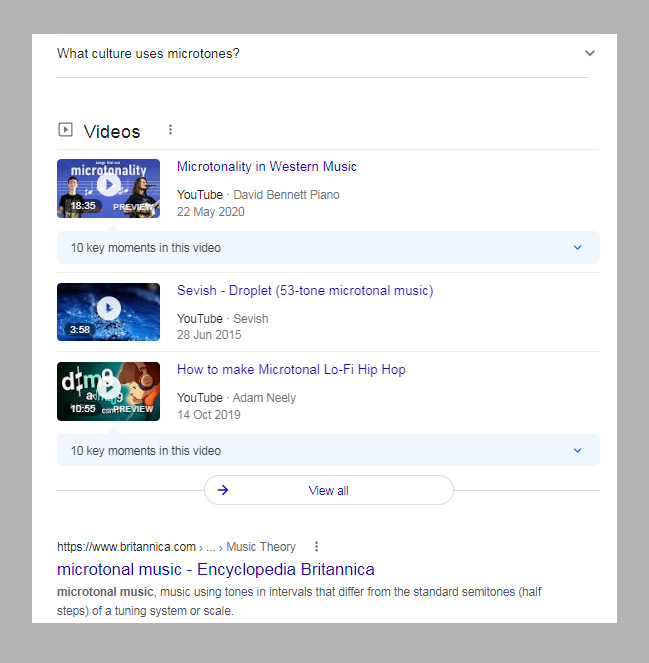
Now, before I show you how to create videos optimized for search engines, I want to first show you how to scale this process up with the Rank Ranger Rank Insights Report…
Rank Insights SERP Features Report
To find video SERP feature options, go Rank Tracker > Rank Insights and go to the SERP Feature report.
By going to this report, you can easily find SERP features to rank your videos. In order to get this data, you’ll have to set up a Google rank tracking campaign and track the target keyword.
Look for video icons that coincide with the video keywords that you want to create.

The Rank Insights SERP Feature report showing a Video Thumbnail
Once you’ve found some video opportunities for both YouTube and Google, it’s time to actually create an SEO-optimized video.
SEO Video Optimization
In the example above where we looked at the video SERPs for the keyword ‘polestar 2 vs tesla model 3’, we saw that the top four results were stable. As I mentioned there, you should use the stable videos as a model to see how to rank your own video (by creating something even better.)
To do that, click on the magnifying glass in the Rank Tracker Dashboard and you’ll see a SERP snapshot.
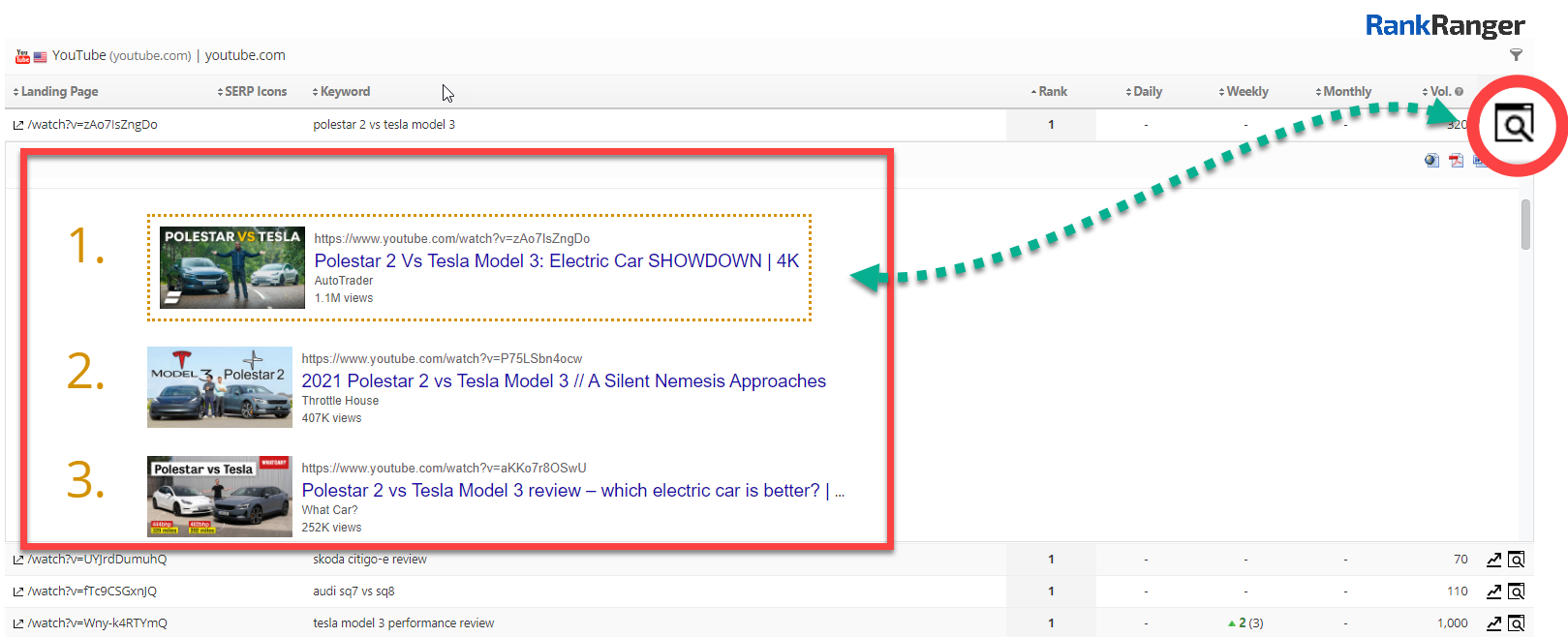
Use the SERP snapshot to look at the video titles and thumbnails. For instance, if you look at the screenshot above, you’ll notice that the keyword ‘polestar 2 vs tesla model 3’ is at the beginning of all the video titles.
Also, you’ll notice that all the titles also include some language that is designed to inspire viewers to click.
For instance, the position one video title includes ‘Electric Car SHOWDOWN I 4k’ after the keyword. The title in position two includes ‘A Silent Nemesis Approaches’ after the keyword.
This means you should structure your video title the same way by including the keyword at the beginning of the title, and by adding a curiosity-inducing copy after.
Also…
You can use the SERP snapshot to see what video formats are ranking.
For instance, for this term, all the videos are comparison videos (comparing Polestar 2 and Tesla Model 3). This means to rank you should create something similar.
Other examples of video formats are:
- How-to videos
- Comparison videos
- List videos
Once you have an idea of the video title and format, clicking the links will take you to the actual videos on YouTube.
This way you can get a sense for what video formats are working. Pay attention to the content and the video production.
Once you know what the top videos look and feel like, your goal is to create a video that provides better information and is even more engaging resulting in a superior user experience.
Video Engagement
The most important part of your video is to have videos that get a lot of engagement. This includes:
- Long watch times
- Many likes
- Many comments
To achieve this you must focus on two things.
- A solid script
- Engaging video production
Understand the Search Intent
To achieve a long watch time it’s important to focus on why a person is watching your video in the first place. In other words, think about the keyword you are creating your video for.
Now imagine yourself typing that keyword into the search engine. What type of user experience are you trying to find?
Is your audience trying to solve a problem? Be entertained?
To figure out search intent, go back to the SERP snapshot or to YouTube and search for your keyword. Try to find clues that will cue you into what your audience is looking for.
If you don’t see anything, try watching the top videos and try to understand how they are answering the search intent. (So much of SEO is reverse-engineering the top rankings.)
Once you’ve figured out the search intent, it’s time to create a script.
Create Your Script
So, how do you create a script that grabs your audience and keeps them watching to the end?
Well, you now understand the search intent. You know what your audience is looking for.
At this point, your goal is to create a script that answers it clearly and comprehensively. But, don’t forget, you are trying to create content that outshines your competitors. This means you should be looking for ways to add value to your videos.
To do this effectively, simply look at the top-performing videos. Note down all the points they make. Then, when planning your script, make sure that you cover all of those points.
Then try to find ways to add value. There is more than one way to do this.
For instance, you can explain some of the points in greater detail, or, you could try to find a way to make the content easier to understand. (Summaries work well.)
Once you know all the points you need to make in your content, try to figure out how to structure your video. Can you do it all in one scene or do you need multiple scenes and multiple locations?
Depending on the scale of your video, you might need to create a storyboard to help you stay organized.
With your storyboard in hand, you can now create the actual script.
Although I’ll be mentioning how to optimize your videos later in this post, it’s important to verbally mention your target keyword in your video a few times.
Make sure to include it in your script.
Let’s move on to video production…
Video Production for Greater Engagement
If you’ve created a script that answers the search intent thoroughly and you’ve found an angle that makes your content more valuable than your competitors.
Your work is not yet done.
Focusing on video production can easily add entertainment value that can increase watch times.
Pace Your Video
Creating the right pace for your video can dramatically improve watch times. The reason? A video that is paced too slowly might bore your audience. If it’s paced too fast, it might be confusing.
Although more art than science, it always pays to go back to the top-ranking videos to see how they are paced.
Pay attention to how these videos are paced. Do they have short energetic scene cuts that keep your attention? Do they break up scenes in a visual way or use music to break things up? If so, you should try to create something similar. This will help to keep your consumers watching until the end.
Also…
Start your video with a brief introduction that explains what the video is about. This will let your audience know if they have found what they are looking for before they get to the body of the content.
Bonus tip…
Give your audience a reason to watch to the end by inspiring curiosity. You can easily do this by promising to reveal something at the end of the video.
Keyword Optimize Your Video
It’s time to create content that’s optimized for search engines.
In order for YouTube and Google to understand and rank your videos, they have to understand what your videos are about. This means you must add your keyword to the words spoken in the video and the metatags.
Google is able to understand the audio and video of your video file. It’s a fair assumption to say that YouTube does the same. This means you should not only include your keyword in your metadata, but you should also say the keyword when recording the audio.
Also, Google crawls the page hosting the video. This means you should include your keyword in the video title, video description, and metatags.
When writing the video description on YouTube, create a mini blog post summing up the key points. By doing this, you’ll give the search engines more context to help them understand what your video is about.
Include Captions
Another way to increase engagement is to add captions.
Studies have shown that captions increase video watch times as viewers often read along when watching. This helps focus the viewer on the content which increases the probability that they will watch to the end.
Also, this will give search engines more context as they can read the captions.
Once you’ve created an engaging video, it’s now time to improve your click-through rate.
Improve Click-Through Rate With an Engaging Thumbnail
As YouTube becomes more competitive, it’s crucial to find a way to stand out on the YouTube SERP. You can do this by creating an attention-grabbing thumbnail that inspires clicks.
To do this, go back to the SERP snapshot and look at the top-ranking video’s thumbnails.
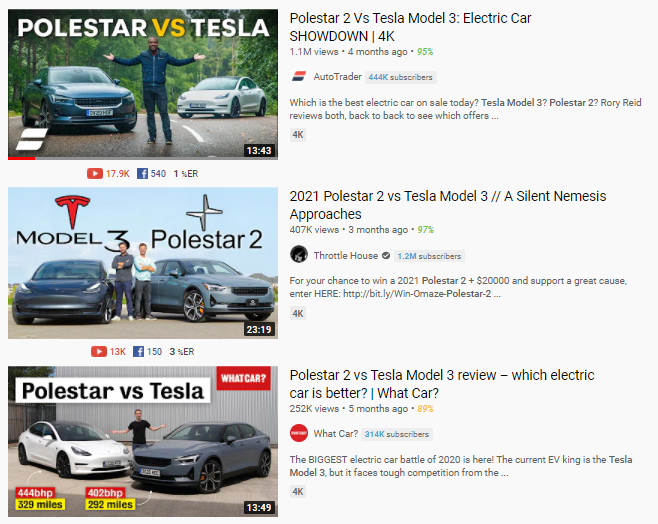
If you look at the thumbnails, you’ll notice that they are all very similar. All three include a high-quality image of the YouTuber standing between a Polestar and a Tesla. These images certainly match the search intent, promising the viewer a comparative review of both cars.
However, if you look again, you’ll notice that the top one stands out because its color palette is different from the other videos on the SERP.
In other words, the top video thumbnail has a green background with yellow and white text.

The next two thumbnails both have similar color palettes both having grey neutral backgrounds with red highlights.
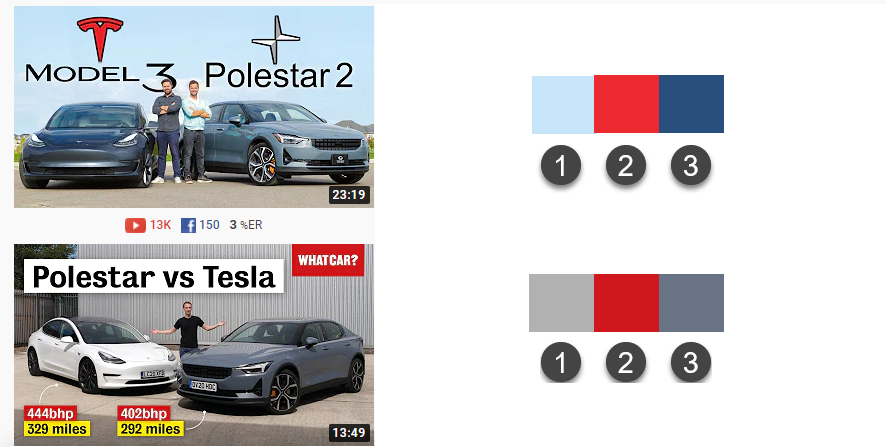
The takeaway here is to always try to get your thumbnail to stand out by using unique color palettes.
You should now have a fairly clear picture of all the basic steps for creating a video that gets traffic.
Create a Dedicated Page for Each Video on your Website
According to Google’s guidelines, if you want your video to get maximum exposure in Google Search, you should create a dedicated page for each video on your website.
To do this, make sure that your video is the most prominent element of the page. This means feature your video at the top of the page. Add a complete transcript under the video.
What’s more, to help search engines understand what your video is about, it’s recommended that you add video schema markup to the page. If you don’t know how to create schema markup, have no fear, you can use the Rank Ranger Schema Markup Generator.
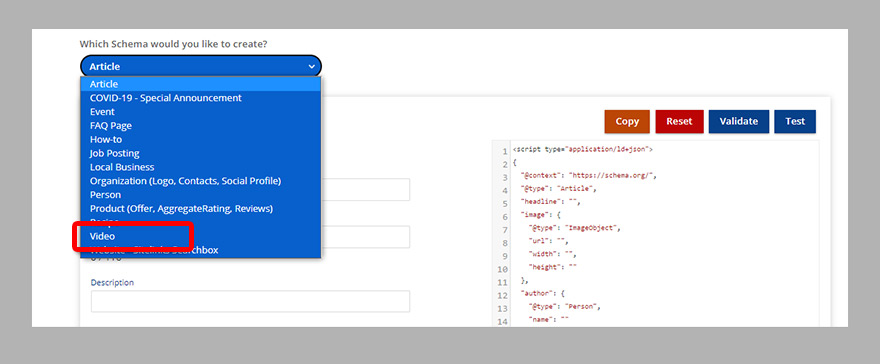
As you can see in the screenshot above, make sure to click ‘Video’ in the blue dropdown menu. Then simply fill in all the fields and the tool will automatically generate your code.
Although there are no guarantees, this will help you to get certain rich results such as the Live Badge and Key Moments.
Create a Dedicated Video Sitemap
Once you have created dedicated video pages to your site, to make sure that Google finds your content, you should create a dedicated video sitemap.
The reason is Google discovers and indexes your web pages by first crawling your site. Sitemaps help Google’s crawlers to find and index your pages.
Social Media Video Tips to Generate Massive Engagement
Yes, the focus of this blog post is on SEO, but as I’m sure you’ve already noticed, just publishing content and hoping it’ll get picked up by search engines is a great recipe to have your content gather dust in an obscure part of Google’s index (like under the fridge.)
This means promoting your video content is crucial. Although it’s not entirely clear that there is a direct SEO benefit to social media promotion, I highly recommend you budget a solid amount of time to social media promotion.
The main reason is the whole point of creating content is for potential customers to consume your content. Social media can often result in hundreds of video views.
What’s more, if you embed your video content on your site (as I mentioned above) and if you’ve created high-impact unique content, you might pick up some well-earned backlinks.
What’s more, getting massive views may help to improve your YouTube rankings.
And what better way than to promote it on social media.
1. Share Often
The fast-paced nature of social media has turned users into goldfish.
Social posts have a really short shelf life.
This means, that even if you’ve posted a video once, don’t be shy to repost the same video more than once. What’s more, if you space your posts out, you’re likely to generate big engagement over time.
2. Send Your Videos to Your Email Lists
I **** email marketing. If you’ve been nurturing an email list for some time, sharing your video content with your email subscribers is a no brainer.
3. Integrate Your Social Media with Your Email List for Massive Engagement
If you’ve been working on both social media and an email list, it might be time to get them to work together strategically.
In other words, if you are strategic and are posting regularly, you might be able to generate email subscribers via social media.
And…
As your email list grows, you can use it to generate massive engagement for your social posts.
But, since there is no space in this post to explain all the details, if you are ready to explode your traffic, check out our Social Media Marketing Strategy post.
Video SEO Marketing Key Takeaways

In this post, I’ve covered the entire video SEO process from beginning to end. We’ve covered how to find the right keywords and how to qualify them. Once you’ve qualified them, I’ve shown you how to make sure that there are opportunities to rank your videos on YouTube and the Google SERPs.
I’ve also given you an overview of how to create an optimized video that’s designed to rank by using the top-ranking videos as a guide.
And of course, don’t forget to promote your videos often.
I’ll add one crucial step…
Always try to make better content than what’s already ranking. This should be your content creation mantra for all SEO content.
You now have all the steps. All that’s left to do is to take action.
FAQ
How do I optimize video content for SEO?
Optimizing video for SEO involves a combination of techniques that focus on both the video content and how it’s presented online. Here are some tips to help you optimize your video content for SEO:
- Use a descriptive title: Your video title should be concise and accurately describe the content of your video. Use keywords that your target audience is likely to search for.
- Include keywords in your video description: The video description should summarize the video content and include relevant keywords. Be sure to include your website or social media links.
- Use video transcripts: Search engines can’t index video content, but they can index text. By providing a transcript of your video, you make it easier for search engines to understand your video content.
- Optimize your video metadata: Metadata includes the video’s file name, tags, and thumbnail image. Use descriptive file names and tags that accurately describe your video content, and use a high-quality thumbnail image to attract viewers.
- Embed videos on your website: Embedding your videos on your website can help increase engagement and drive traffic to your site. Be sure to include a descriptive title and video description on the page where the video is embedded.
- Promote your video on social media: Sharing your video on social media can help increase its visibility and attract more views. Be sure to include a link to the video on your website or YouTube channel.
- Monitor your video’s performance: Use your rank tracker to monitor your video’s performance and make adjustments as needed. This will help you identify areas where you can improve your video’s SEO and engagement.
What does video SEO mean?
Video SEO refers to the process of optimizing video content for search engines in order to increase their visibility and ranking in search engine results pages (SERPs). The goal of video SEO is to ensure that your videos are discoved by search engines and appear in relevant search results for users searching for related topics or keywords.
Video SEO involves a variety of techniques, including optimizing video metadata (such as title, description, tags, and thumbnail image), using closed captions or transcripts to improve accessibility and indexing, and incorporating relevant keywords throughout the video and surrounding content (such as titles and descriptions).
By optimizing your video content for search engines, you can increase its visibility, drive traffic to your website or platform, and ultimately reach a wider audience.

